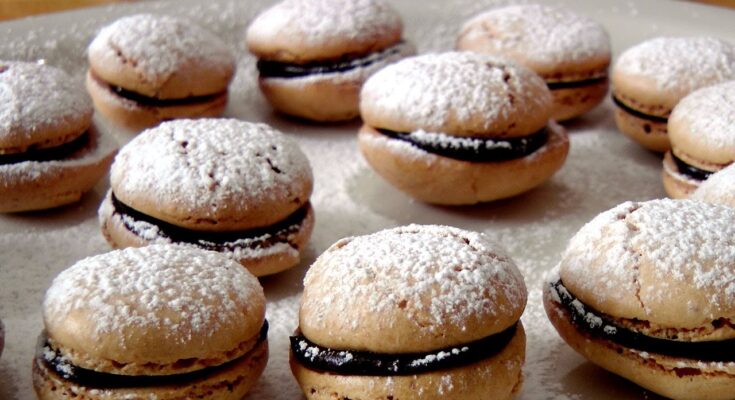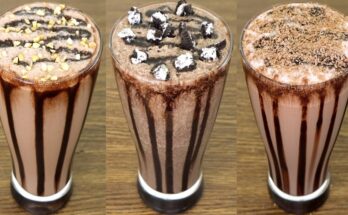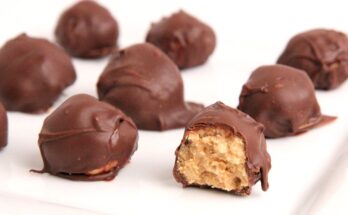Macaroon Recipe: Macaroons are delightful little treats, often characterized by their chewy texture, sweet coconut flavor, and golden-brown exterior. Not to be confused with the French “macaron,” macaroons are typically made with shredded coconut, egg whites, and sweeteners like sugar or condensed milk. They’re simple to make and incredibly versatile, making them a favorite in both novice and experienced kitchens.
Unlike many fancy pastries that require special equipment or a culinary degree to prepare, macaroons come together with just a handful of basic ingredients. What’s more, their naturally gluten-free base makes them a hit among those with dietary restrictions. Whether served plain or dipped in chocolate, these little bites are guaranteed crowd-pleasers.
If you’re just getting into baking, macaroons are a fantastic entry-level recipe. They’re forgiving, fun, and fast to whip up. Plus, they offer plenty of room for creativity—think lemon zest, almond extract, or even a drizzle of caramel.
Difference Between Macaroons and Macarons
Let’s get one thing straight: macaroons and macarons are not the same. Though the names sound nearly identical, the two are entirely different in texture, preparation, and presentation.
Macaroons, as mentioned, are coconut-based and typically have a rough, rustic look. They’re chewy, moist, and easy to bake in under 30 minutes. Macarons, on the other hand, are delicate sandwich cookies made with almond flour and meringue, filled with buttercream or ganache, and known for their smooth tops and signature “feet.”
While macarons require technique, patience, and precision, macaroons offer a laid-back, casual baking experience. So if you’re looking for something sweet, easy, and satisfying without breaking a sweat, macaroons are the way to go.
Ingredients Needed for Macaroons
Key Ingredients
To keep things simple and authentic, here’s your basic list of what you’ll need for a traditional coconut macaroon recipe:
- 3 cups sweetened shredded coconut
- 4 large egg whites
- ¾ cup granulated sugar (or ½ cup condensed milk for richer taste)
- 1 tsp pure vanilla extract
- A pinch of salt
These ingredients create the perfect chewy, sweet, and golden-brown macaroon every time. The coconut provides texture and body, the egg whites bind everything together, and sugar adds the essential sweetness. Vanilla enhances the overall flavor profile while a pinch of salt balances it out beautifully.
Don’t skip on quality—use fresh eggs, high-quality coconut, and pure vanilla extract. The fewer the ingredients, the more each one stands out.
Optional Add-ins and Flavor Twists
Want to take your macaroons to the next level? Try these creative add-ins and flavor variations:
- Chocolate chips: Stir in semi-sweet or dark chocolate chips.
- Lemon or orange zest: For a fresh citrusy note.
- Almond extract: Swaps well with vanilla for a nuttier depth.
- Chopped nuts: Pecans, walnuts, or almonds work great.
- Dried fruits: Think cranberries, raisins, or chopped apricots.
And for the finishing touch? Dip the bottoms in melted chocolate once cooled or drizzle chocolate on top for a fancy feel. These little extras can completely transform the flavor and appearance, making your macaroons suitable for any occasion.
Kitchen Tools You’ll Need
Essential Baking Tools
Before you dive into baking, gather your tools. Here’s what you’ll need to streamline the process:
- Mixing bowls
- Measuring cups and spoons
- Whisk or electric hand mixer
- Baking sheet
- Parchment paper or silicone baking mat
These are the basics. A sturdy baking sheet ensures even cooking, while parchment paper prevents sticking and makes cleanup a breeze. If you’re using sweetened condensed milk instead of sugar, you’ll only need a spatula and spoon to mix.
Prep Tools for Best Results
For those looking to perfect their presentation, consider adding these:
- Cookie scoop: For uniform shapes
- Cooling rack: Helps maintain texture post-baking
- Double boiler or microwave-safe bowl: For melting chocolate
These optional tools might not be mandatory, but they do enhance the end result. Uniform size helps with even baking, and a good cooling rack ensures your macaroons don’t get soggy bottoms.
Step-by-Step Macaroon Recipe Guide
Step 1: Preparing Your Ingredients
Before you start mixing and baking, preparation is everything. Take the time to measure out all your ingredients and set them on the counter. Preheat your oven to 325°F (163°C)—a moderate temperature that allows the macaroons to bake slowly and evenly without burning the coconut.
If you’re using egg whites, separate them from the yolks carefully. Even a tiny bit of yolk can prevent the whites from whipping properly if you’re using a mixer. For sweetened condensed milk versions, you can skip the whisking and just mix everything together. Lay out your parchment paper on the baking sheet and have your mixing bowls and utensils ready.
Proper prep ensures that your baking process is smooth, reduces the chances of mistakes, and helps maintain consistency in texture and taste.
Step 2: Mixing the Base
This step is where the magic starts. In a large mixing bowl, whisk the egg whites until they are frothy. This doesn’t require stiff peaks—just enough to break them down and add some air for lightness. If using sugar instead of condensed milk, add it now and whisk until the mixture becomes somewhat glossy and thickened.
Next, fold in the shredded coconut. Stir gently to ensure all the coconut is coated evenly with the egg mixture. Add the vanilla extract and salt, then give everything a final gentle mix. The mixture should be thick and sticky, not too wet or runny.
If you’re adding chocolate chips, nuts, or zest, now is the time to fold them in. Just be careful not to overmix, as this could break down the air in the egg whites, resulting in denser macaroons.
Step 3: Shaping the Macaroons
Time to shape your cookies! Use a tablespoon or a small cookie scoop to portion the mixture onto your prepared baking sheet. Space them about an inch apart—these cookies don’t spread much, but a little room is good for airflow.
If the mixture is too sticky, lightly wet your hands or the scoop with water. This makes handling much easier and gives the macaroons a neater, rounded shape. Press them gently into little mounds—don’t flatten them out; they should resemble mini haystacks or domes.
Getting the shape right is more than just aesthetics. A well-shaped macaroon bakes evenly, with a golden crust and a chewy, moist interior. Irregularly shaped ones might burn at the tips or stay undercooked in the middle.
Step 4: Baking to Perfection
Slide the tray into the preheated oven and set your timer for 20 to 25 minutes. Keep an eye on them during the last few minutes. You’re looking for the perfect golden brown hue on the tops and edges. The interior should remain soft and moist, not dry.
Every oven is a little different, so it’s okay to check them at the 20-minute mark. If they look pale, give them a few more minutes. If they’re browning too fast, you can lightly tent the tray with foil to prevent over-baking.
Do not open the oven door too often, as it can drop the temperature and affect even baking. Patience here pays off—you’ll know they’re done when they’re lightly golden and firm to the touch.
Step 5: Cooling and Optional Dipping
Once baked, let the macaroons cool on the tray for about 10 minutes. Then, transfer them to a cooling rack to finish setting. They’ll continue to firm up as they cool, so don’t worry if they feel slightly soft at first.
If you’re feeling indulgent, melt some chocolate (semi-sweet or dark works best) and dip the bottoms of each macaroon. Place them on a fresh piece of parchment paper and refrigerate for 10–15 minutes to set the chocolate.
This final touch adds richness and a beautiful contrast of flavors. Plus, who doesn’t love the combo of coconut and chocolate? If you’re serving them for a party or holiday, this small addition can elevate the entire dessert table.
Common Mistakes and How to Avoid Them
Preventing Overbaking
One of the biggest pitfalls in macaroon making is overbaking. Coconut is sensitive and can burn quickly. The line between beautifully golden and scorched is thin, so watch carefully in the last 5 minutes.
To avoid this, always bake at a moderate temperature and use the middle rack. If your oven runs hot, consider lowering the temp slightly or baking for a shorter time. Also, using parchment paper instead of greasing the tray can prevent overbrowning on the bottom.
Another tip—don’t make them too small. Tiny macaroons bake faster and can dry out. Stick to tablespoon-sized scoops for best results.
Avoiding Dryness or Crumbliness
Dry macaroons are usually the result of too much egg white or not enough sugar/fat content. To prevent this, always measure your ingredients accurately. If you’re using unsweetened coconut, consider increasing the sugar slightly or adding a bit of condensed milk to compensate.
Also, don’t overmix. Once the ingredients are combined, stop stirring. Overworking the mixture can break down the coconut and egg whites, leading to a dense, crumbly texture.
Finally, store your macaroons properly (more on that next!) to preserve their chewy, moist bite.
Serving and Storing Macaroons
Best Ways to Serve Macaroons
Macaroons are incredibly versatile when it comes to serving. They can be the star of your dessert table or a charming sidekick to a cup of coffee or tea. Their sweet, chewy nature makes them a hit for almost any occasion—from holiday gatherings and weddings to casual afternoon snacks.
For an elegant presentation, arrange them on a tiered cake stand or a rustic wooden board. Garnish with a sprinkle of powdered sugar or a drizzle of white chocolate for added flair. You can also pair them with fresh berries or fruit preserves for a more sophisticated twist.
If you’re serving them after dinner, try plating them with a scoop of vanilla ice cream or alongside a warm cup of espresso. Their texture complements creamy desserts perfectly, adding both contrast and richness.
Want to impress guests or gift them? Pack the macaroons in a clear treat bag tied with ribbon, or use a decorative box lined with parchment. These cookies hold their shape well and make fantastic edible gifts.
Storage Tips for Freshness
Once you’ve baked a batch (or two), proper storage ensures your macaroons stay fresh, chewy, and delicious for days. First, let them cool completely. Warm macaroons stored too early can trap moisture and become soggy.
Store them in an airtight container at room temperature. They’ll last about 5–7 days this way. Layer them with parchment paper in between to prevent sticking.
If you need them to last longer, refrigerate or freeze:
- Refrigeration: Keeps them fresh for up to two weeks. Use an airtight container and bring to room temperature before serving.
- Freezing: Place cooled macaroons in a single layer on a baking sheet to flash-freeze. Once solid, transfer them to a freezer-safe bag or container. They’ll keep for up to 3 months. Thaw at room temp before enjoying.
Avoid storing them in humid or warm areas, as this can cause them to become sticky or overly soft. Always reseal the container after opening to lock in freshness.
FAQs about Macaroon Recipe
1. What is the difference between macaroons and macarons?
Macaroons are chewy cookies made with shredded coconut, egg whites, and sugar. Macarons, on the other hand, are delicate French sandwich cookies made with almond flour and meringue. While they sound similar, they’re very different in texture and taste.
2. Can I use sweetened or unsweetened coconut for macaroons?
Yes, but it depends on your preference. Sweetened coconut makes the macaroons more moist and dessert-like, while unsweetened gives you more control over sugar content.
3. Why do my macaroons spread too much?
This could be due to excess moisture in the mixture. Make sure your egg whites are not too runny and avoid overmixing. Also, chill the dough before baking for better structure.
4. How do I store homemade coconut macaroons?
Store them in an airtight container at room temperature for up to 5 days. For longer storage, keep them in the fridge for up to 2 weeks or freeze for up to 3 months.
5. Can I make macaroons without eggs?
Yes! For an egg-free version, you can use aquafaba (the liquid from canned chickpeas) as a substitute for egg whites. It whips up similarly and still gives that chewy texture.
6. Are macaroons gluten-free?
Most classic coconut macaroons are naturally gluten-free since they don’t use flour. Always double-check the ingredients if you’re buying or adapting a recipe.
7. Why did my macaroons burn at the bottom?
Baking them on a parchment-lined baking sheet or using a silicone mat can help prevent burning. Also, bake at the recommended temperature and avoid placing the tray too low in the oven.
8. Can I dip my macaroons in chocolate?
Absolutely! Dipping the bottom or drizzling melted chocolate over the top adds a delicious twist and makes them even more indulgent.
9. Do I need to beat the egg whites separately?
Not for traditional macaroons. You usually just mix the egg whites into the coconut and sugar mixture. However, whipping them separately can give a lighter texture if preferred.
10. Can I flavor my macaroons?
Yes! You can add vanilla extract, almond extract, citrus zest, or even cocoa powder for variation. Just don’t overdo it—balance is key.
Conclusion
Macaroons are proof that delicious things don’t have to be complicated. With just a few simple ingredients and a little care, you can whip up a batch of golden, chewy, coconutty delights that’ll impress just about anyone. Whether you’re baking them for a special occasion or just because you’re craving something sweet, this foolproof recipe has got you covered.
From prepping your ingredients to that satisfying first bite, macaroons are one of those baked goods that feel rewarding every step of the way. So go ahead—experiment with flavors, dip them in chocolate, or enjoy them plain. Either way, you’re in for a treat that’s as timeless as it is tasty.



